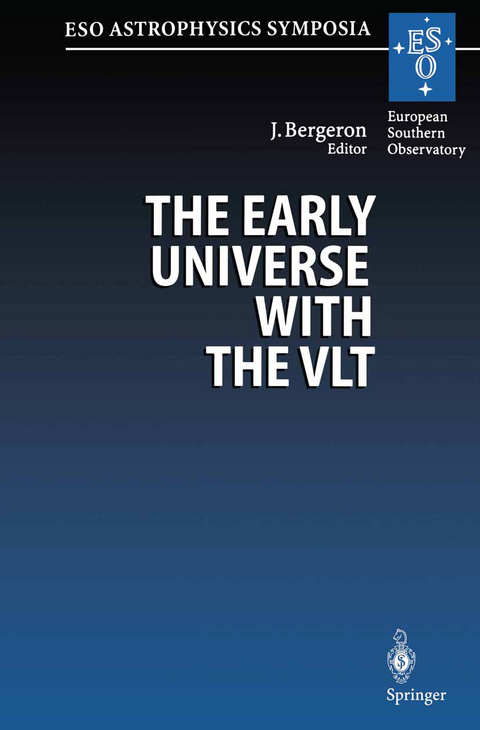
The Early Universe with the VLT
Springer Berlin (Verlag)
978-3-662-22488-5 (ISBN)
Cosmological Questions for the European Southern Observatory Very Large Telescope.- The VLT First Generation Instrument Capabilities as Cosmological Tools.- ISAAC - IR Spectrometer and Array Camera.- Observing the Early Universe with CONICA.- Spectroscopy of Faint Distant Objects with FORS.- FUEGOS: Multi-Objects and 2-D Spectrograph for the VLT.- The ESO UV-Visual Echelle Spectrograph (UVES).- Galaxy Evolution at z ? 1.- Evolution of Normal Galaxies: HST Morphologies and Deep Spectroscopy.- The Canada France Redshift Survey.- Galaxy Evolution: Luminosities and Linewidths.- Distant Supernovae and Cosmic Deceleration.- Evolution of Elliptical Galaxies up to z ? 1.- Constraining the Evolution of Galaxy Masses and the M/L Ratios out to z=1.- 2D Spectroscopy of Remote Radiogalaxies with TIGER.- Spectro-Imaging of Starburst Galaxies: Present and Future.- Search for Highest Redshift Galaxies.- Keck Spectroscopy of Redshift z ~ 1 Field Galaxies.- VIRMOS: Deep Redshift Surveys with the VLT.- The AUSTRALIS Instrument Concept - an Interim Report.- Numerical Simulations of Galaxy Formation.- The Calar Alto Deep Imaging Survey for Primeval Galaxies.- Faint Emission Line Galaxies Detected in CADIS.- A Global Approach to Star and Galaxy Formation.- Metal Absorption from Galaxies in the Process of Formation.- Weak Lensing at the Limit of the Sky Background Noise.- Morphology of High Redshift Galaxies with HST.- Search for Galaxies at z > 4 from a Deep Multicolor Survey.- Clusters and Large-Scale Structure.- Large-Scale Structure at High Redshift.- The CNOC Cluster Survey.- Clusters of Galaxies and the VLT.- Visible Multi-Object Spectroscopy: Prospects and Requirements.- Dark Matter Searches with Weak Gravitational Lensing.- Large-Scale Structure at High Redshift.- Clusteringof Absorption Line Systems.- Searches for High Redshift Clusters.- First Active Objects.- High Redshift Radio Galaxies with the VLT.- Keck Spectropolarimetry of High z Radio Galaxies: Discerning the Components of the Alignment Effect.- The Importance of IR Polarimetry for the Study of High Redshift Galaxies.- Quasar Surveys.- Starburst Galaxies at High Redshift.- Prospects for ISO Deep Surveys.- Optical Searches for Quasars with z > 5.- Dust and the Search for High Redshift Quasars.- Radio-Selected High Redshift Quasars.- Millimetre Emission from High Redshift Radioquiet Quasars.- Can Photoionization Solve the Overcooling Problem? A Quick Look at the Cosmological History of Baryons.- Concluding Remarks.- Which Second Generation VLT Instrumentation?.- Poster Papers.- Galaxy Evolution at Low Redshift? Inferences from Optical and IR Counts.- Novae as Distance Indicators: Simulation of VLT Observations of Fornax.- The Search for Clustering at z > 0.8.- Emission-Line Profile Studies of QSOs at z ? 3.- Redshift and Photometric Survey of the X-ray Cluster of Galaxies Abell 85.- CFRS: The Minimal Ages for Starburst Galaxies.- Object Detection and Classification in CADIS.- Simulations of High Redshift Galaxies Colors at the NTT-SUSI2 and VLT-FORS.- Spectral Classification of Galaxies with z ? 0.5.- The Galaxy Environment of QSOs as a Function of Redshift.- Detailed Kinematics of Extended Lyman-? Regions Around Radio Galaxies at z > 2.- AGN Host Galaxies at Intermediate Redshift.- Void Hierarchy - a Guiding Principle to the Study of Faint Structures in Voids.- Implications for Optical Identifications of QSO Absorption Systems from Galaxy Evolution Models.- The Extended Luminosity Function in Clusters of Galaxies: a Tool to Search for Environmental Effects.- A HighRedshift Line Emitting Object Discovered in the Near Infrared.- Looking for High Redshift Forming Galaxies in the Near Infrared.- Neoclassic Cosmological Tests with QSOs.- Chemical Evolution at High Redshift.- Measurement of q 0 with Type Ia Supernovae.- Spectrophotometric Investigations of Blue Compact Dwarf Galaxies with the VLT.- A Deep 20 cm Radio Mosaic of the ESP Galaxy Redshift Survey.- A New Model of Spectral Evolution: PEGASE Application to Galaxy Counts.- An H? Search for Star Forming Galaxies at z=1.5.- RXJ1347-1145: a Galaxy Cluster with Exceptional Properties.- A Survey for H? Emission at z = 2.2 - 2.4.- Neutral Nitrogen in Damped Lyman a Systems.- Colours, Luminosity Functions, and Clustering Properties of Faint Starburst Galaxies.- Large-Scale Structure at z ~ 3.
| Erscheint lt. Verlag | 20.11.2013 |
|---|---|
| Reihe/Serie | ESO Astrophysics Symposia |
| Zusatzinfo | XXII, 441 p. 227 illus., 14 illus. in color. |
| Verlagsort | Berlin |
| Sprache | englisch |
| Maße | 155 x 235 mm |
| Gewicht | 652 g |
| Themenwelt | Naturwissenschaften ► Geowissenschaften ► Geophysik |
| Naturwissenschaften ► Physik / Astronomie ► Astronomie / Astrophysik | |
| Schlagworte | active galactic nuclei • active objects • clusters • Cosmology • Early Universe • Galaxy • Galaxy Evolution • Gravitation • gravitational lens • Gravity • Large-Scale • Observatory • quasars • Redshift • spectroscopy • Star • Structure • Supernova • telescope • Universe |
| ISBN-10 | 3-662-22488-7 / 3662224887 |
| ISBN-13 | 978-3-662-22488-5 / 9783662224885 |
| Zustand | Neuware |
| Haben Sie eine Frage zum Produkt? |
aus dem Bereich


